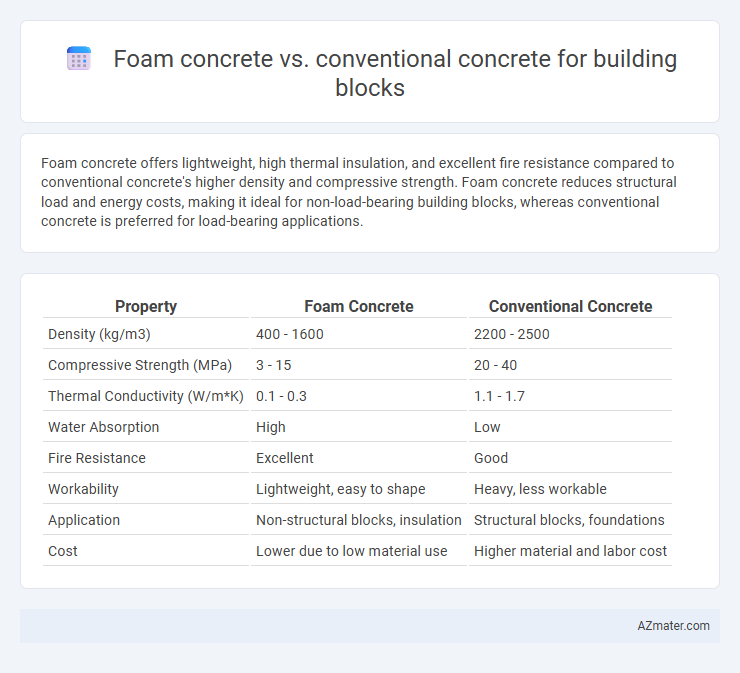Foam concrete offers lightweight, high thermal insulation, and excellent fire resistance compared to conventional concrete's higher density and compressive strength. Foam concrete reduces structural load and energy costs, making it ideal for non-load-bearing building blocks, whereas conventional concrete is preferred for load-bearing applications.
Table of Comparison
| Property | Foam Concrete | Conventional Concrete |
|---|---|---|
| Density (kg/m3) | 400 - 1600 | 2200 - 2500 |
| Compressive Strength (MPa) | 3 - 15 | 20 - 40 |
| Thermal Conductivity (W/m*K) | 0.1 - 0.3 | 1.1 - 1.7 |
| Water Absorption | High | Low |
| Fire Resistance | Excellent | Good |
| Workability | Lightweight, easy to shape | Heavy, less workable |
| Application | Non-structural blocks, insulation | Structural blocks, foundations |
| Cost | Lower due to low material use | Higher material and labor cost |
Introduction to Foam Concrete and Conventional Concrete
Foam concrete is a lightweight, aerated material created by mixing cement, water, and foam to produce air bubbles that reduce density, making it ideal for insulation and non-load-bearing applications. Conventional concrete, composed of cement, water, sand, and aggregates, is dense and strong, commonly used for structural building blocks requiring high compressive strength. Foam concrete offers improved thermal insulation and reduced weight compared to conventional concrete, which provides superior durability and load-bearing capacity in construction.
Composition and Material Differences
Foam concrete is composed of cement, sand, water, and pre-formed foam, which creates air bubbles and results in a lightweight, porous structure, whereas conventional concrete consists primarily of cement, sand, gravel, and water for a denser and stronger composition. The key material difference lies in the inclusion of foam in foam concrete, reducing density and improving insulation properties without significantly compromising compressive strength needed for building blocks. Conventional concrete building blocks offer higher load-bearing capacity due to coarse aggregates, while foam concrete blocks are favored for thermal insulation and ease of handling due to their lower weight and homogeneous composition.
Structural Properties Comparison
Foam concrete exhibits lower density and higher thermal insulation compared to conventional concrete, making it suitable for non-load-bearing blocks. Conventional concrete offers superior compressive strength and durability, essential for structural load-bearing applications. The reduced weight of foam concrete results in easier handling and faster construction but compromises structural integrity relative to standard concrete blocks.
Weight and Density Considerations
Foam concrete offers significantly lower density, typically ranging from 400 to 1600 kg/m3, compared to conventional concrete's density of around 2400 kg/m3, resulting in lighter building blocks that reduce structural load and foundation costs. The reduced weight of foam concrete blocks enhances ease of handling and transportation, improving construction efficiency and lowering labor expenses. Lower density also contributes to better thermal insulation properties, making foam concrete an energy-efficient alternative for building blocks in various construction applications.
Thermal and Acoustic Insulation Performance
Foam concrete exhibits superior thermal insulation properties compared to conventional concrete due to its lightweight cellular structure, which reduces heat transfer and helps maintain indoor temperature stability. The air-filled pores in foam concrete also enhance acoustic insulation by absorbing sound waves more effectively, resulting in quieter indoor environments. Conventional concrete, with its dense composition, provides less thermal and acoustic insulation but offers higher structural strength for load-bearing applications.
Workability and Construction Ease
Foam concrete offers superior workability compared to conventional concrete due to its lightweight and flowable nature, which allows easier molding and placement in complex forms without heavy compaction. The reduced density of foam concrete minimizes the labor intensity and speeds up construction processes, making it ideal for blocks that require fast setting and finishing. Conventional concrete, being denser and less flowable, often demands more effort in handling and compaction, leading to longer construction times and increased labor costs.
Environmental Impact and Sustainability
Foam concrete significantly reduces environmental impact compared to conventional concrete by using less cement and incorporating air bubbles that decrease material density, leading to lower carbon emissions during production. Its enhanced insulation properties contribute to energy efficiency in buildings, promoting sustainability by reducing heating and cooling demands. Additionally, foam concrete's lightweight nature minimizes transportation energy and structural load on foundations, further supporting eco-friendly construction practices.
Cost Analysis and Economic Viability
Foam concrete offers significant cost savings over conventional concrete due to its lower material density and reduced cement usage, leading to decreased transportation and handling expenses. The lightweight nature of foam concrete reduces structural load and foundation costs, enhancing economic viability for building block applications. Despite higher initial mixture preparation costs, the overall savings in labor, energy efficiency, and faster construction times make foam concrete a more cost-effective and sustainable choice compared to traditional concrete blocks.
Typical Applications in Building Blocks
Foam concrete is ideal for lightweight building blocks used in non-load-bearing walls, insulation panels, and partition walls due to its excellent thermal insulation and soundproofing properties. Conventional concrete remains preferred for load-bearing building blocks, structural walls, and foundations because of its superior strength and durability. Both materials cater to distinct building block applications, optimizing structural performance and energy efficiency depending on the project's requirements.
Conclusion: Choosing the Right Concrete for Your Project
Foam concrete offers superior insulation, lightweight properties, and ease of handling compared to conventional concrete, making it ideal for energy-efficient, non-load-bearing building blocks. Conventional concrete provides higher compressive strength and durability suitable for structural applications requiring load-bearing capabilities. Selecting the right concrete depends on project priorities such as thermal performance, structural requirements, and cost-effectiveness.

Infographic: Foam concrete vs Conventional concrete for Building block
 azmater.com
azmater.com